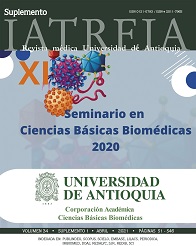Identificación de compuestos antiarbovirus mediante bioprospección de plantas nativas colombianas de la familia solanaceae y análisis metabolómico de la respuesta celular frente al efecto antiviral
DOI:
https://doi.org/10.17533/udea.iatreia.345543Palabras clave:
antiviral, bioprospección, infecciones por arbovirus, metabolómica, SolanaceaeResumen
Las epidemias generadas por los virus (ZIKV, DENV, CHIKV) han sido declaradas emergencia de salud pública global, ya que no existen tratamientos específicos para estas enfermedades. La mayor fuente de moléculas de interés farmacológico han sido los productos naturales, y a pesar de la biodiversidad de Colombia, existen pocos estudios que evalúan su potencial antiviral. La familia Solanaceae está amplia-mente distribuida en la región andina, incluyendo el departamento de Risaralda y se caracteriza por tener abundantes alcaloides esteroidales y compuestos fenólicos, los cuales en estudios recientes de antivirales desarrollados por nuestro grupo de investigación han mostrado su potencial antiviral.
Descargas
Citas
(1) Mushtaq, M.Y., et al., Extraction for metabolomics: access to the metabolome. Phytochemical Analysis, 2014. 25(4): p. 291-306.
(2) Guido, R.V.C., A.D. Andricopulo, and G. Oliva, Planejamento de fármacos, biotecnologia e química medicinal: aplicações em doenças infecciosas. Estudos Avançados, 2010. 24: p. 81-98.
(3) Braz Filho, R., Contribuição da fitoquímica para o desenvolvimento de um país emergente. Química Nova, 2010. 33: p. 229-239.
(4) Estoppey, D., et al., The Natural Product Cavinafungin Selectively Interferes with Zika and Dengue Virus Replication by Inhibition of the Host Signal Peptidase. Cell Rep, 2017. 19(3): p. 451-460.
(5) Beckham, J.D. and K.L. Tyler, Arbovirus Infections. Continuum (Minneapolis, Minn.), 2015. 21(6 Neuroinfectious
Disease): p. 1599-1611.
(6) Wilder-Smith, A., et al., Epidemic arboviral diseases: priorities for research and public health. The Lancet Infectious Diseases, 2017. 17(3): p. e101-e106.
(7) GUBLER, D.J., Human Arbovirus Infections Worldwide. Annals of the New York Academy of Sciences, 2001. 951(1): p. 13-24.
(8) Qu, Y., et al., Effects of socio-economic and environmental factors on the spatial heterogeneity of dengue fever investigated at a fine scale. Geospat Health, 2018. 13(2).
(9) Mishra, S., A. Pandey, and S. Manvati, Coumarin: An emerging antiviral agent. Heliyon, 2020. 6(1): p. e03217.
(10) Zandi, K., et al., Novel antiviral activity of baicalein against dengue virus. BMC Complementary and Alternative Medicine, 2012. 12(1): p. 1185-1185.
(11) Voge, N.V., et al., Metabolomics-Based Discovery of Small Molecule Biomarkers in Serum Associated with Dengue Virus Infections and Disease Outcomes. PLOS Neglected Tropical Diseases, 2016. 10(2): p. e0004449-e0004449.
(12) Newman, D.J. and G.M. Cragg, Natural products as sources of new drugs over the 30 years from 1981 to 2010. Journal of natural products, 2012. 75(3): p. 311-335.
(13) N., et al., Antibacterial, antiproliferative and antioxidant activity of leaf extracts of selected Solanaceae species. 2017.
(14) Mosquera, O., Y. Correa, and J. Niño, Antibacterial activity of some Andean Colombian plants. Pharmaceutical
biology, 2004. 42(7): p. 499-503.
(15) Martinez-Gutierrez, M., et al., Lovastatin delays infection and increases survival rates in AG129 mice infected with dengue virus serotype 2. PloS one, 2014. 9(2): p. e87412.
(16) Arthan, D., et al., Antiviral isoflavonoid sulfate and steroidal glycosides from the fruits of Solanum torvum. Phytochemistry, 2002. 59(4): p. 459-463.
(17) Perez, R.M., Antiviral Activity of Compounds Isolated From Plants. Pharmaceutical Biology, 2003. 41(2): p.
-157.
Descargas
Publicado
Cómo citar
Número
Sección
Licencia
Derechos de autor 2021 Universidad de Antioquia

Esta obra está bajo una licencia internacional Creative Commons Atribución-NoComercial-CompartirIgual 4.0.
Los artículos publicados en la revista están disponibles para ser utilizados bajo la licencia Creative Commons, específicamente son de Reconocimiento-NoComercial-CompartirIgual 4.0 Internacional.
Los trabajos enviados deben ser inéditos y suministrados exclusivamente a la Revista; se exige al autor que envía sus contribuciones presentar los formatos: presentación de artículo y responsabilidad de autoría completamente diligenciados.














